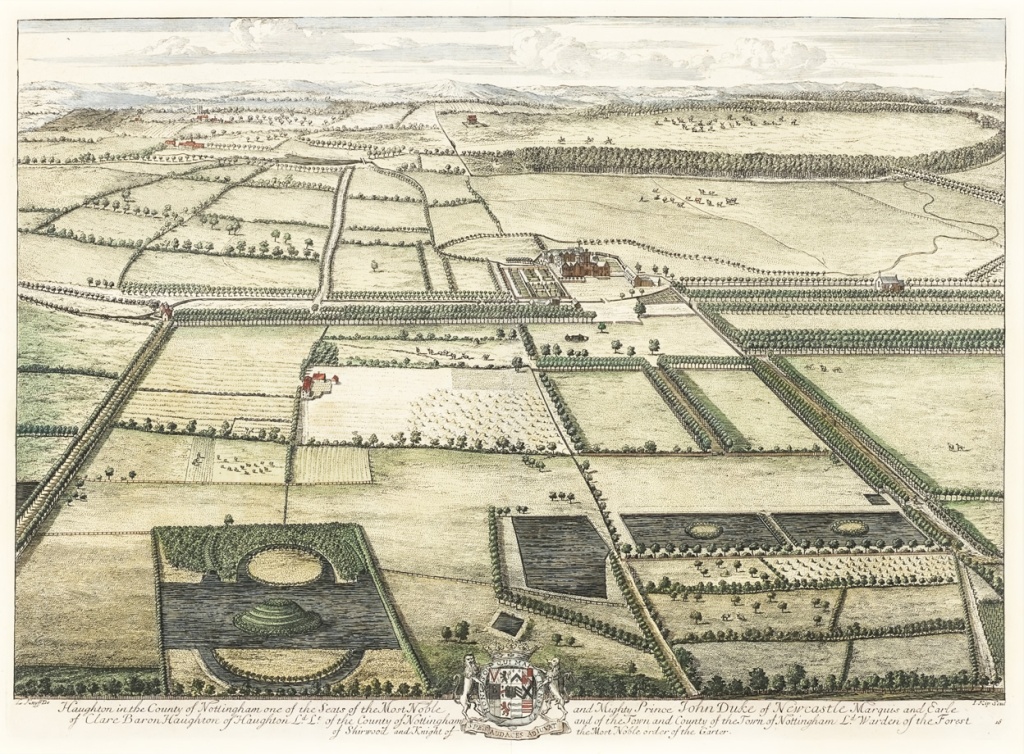← Previous: John Rochford V of Fenne (died c1534)
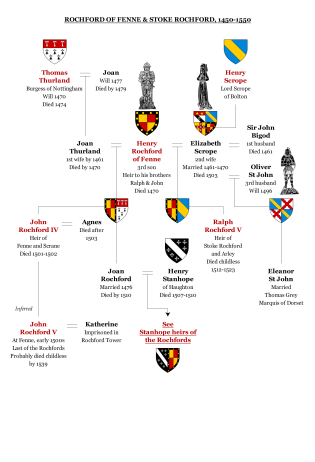
Way back in 1476, a few years after Thomas Thurland died, his widow Joan Thurland was busy thrashing out the finer points of a marriage agreement. It was for her orphaned granddaughter Joan Rochford, whose father Henry had died in 1470 – and it was not before time. The old widow knew she did not have long to live and the young Joan would soon become the responsibility of her brother John Rochford IV. There could be no certainty in these dark times that he would care to invest his own inheritance securing a good marriage for his sister.
On 28 September 1476 old “Dame Jane Thyrlande” and John Stanhope, a former sheriff and MP of Nottinghamshire, met at Nottingham to finalise the deal. The young Joan was to marry Stanhope’s younger son Henry. The two families agreed to “bear the costs of the dinner and apparel evenly between them” for the wedding ceremony, but most of the negotiations had been over who was to give what property to the newly-wed couple, to ensure them a good start in life together. John Stanhope agreed to give them an estate worth £20 a year, “to find them two years’ meat and drink and chamber”, and also to leave them property at Willoughby, Walesby, Kirton, Haughton, Boughton, Tuxford, Darlton and Treswell in Nottinghamshire, worth £46 13s 4d a year, after he and his wife died. Joan Thurland, for her part, agreed to give the couple £50 worth of plate and household goods, and to pay John Stanhope 300 marks in cash or silver in three equal installments: one on the day of the wedding itself, another on 11 November 1477, and the last on the same date the next year. Finally, given the considerable value of the agreement, both parties agreed to be bound to it for penalties of 400 marks. On 1 October 1476 the bonds were signed and shortly afterwards Henry Stanhope and Joan Rochford were married, probably on 11 November.
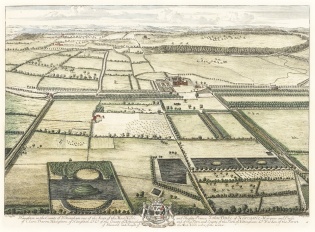
It was less than a year later when old Joan Thurland wrote her will, but she lived on for a couple of years, probably until 1479. On 21 July that year her executors had approval to wrap up her estates. John Stanhope, meanwhile, lived until 1493. The legal arrangements he made for Henry and Joan’s property were perhaps less clear than they should have been. For eighteen years, from about 1500 onwards, the couple and their heirs would be involved in endless legal rows with their Stanhope cousins over these estates. They would also face more tragic mortality than even their Rochford kin could match.
Henry and Joan had a son, Edmund, who was probably born soon after they were married, and definitely by about 1484. Joan died before Henry, probably well before 1510, so she did not reach the age of sixty. She was buried in the now-ruined chapel of Haughton near Tuxford in Nottinghamshire, where her father-in-law had given her and Henry property on their wedding. The antiquarian John Throsby wrote about the chapel and Joan’s tomb in his 1796 History of Nottinghamshire:
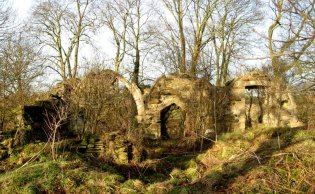
“Haughton Chapel. I found a little pleasing ruin, surrounded by a young plantation of trees … It had, by what is visible at present, only a nave and north cemetery, or burial place … In the chapel is an old floor-stone with a cross … The male arms on this stone are those of Longviller, borne, at that time, by the family of Stanhope … The female, are much injured.”
Gervase Holles visited this chapel in the 1600s, and he reported that the female arms looked like “a cross within a bordure”. These must have been the traditional Rochford arms, the quarterly division appearing like a cross. The inscriptions on the stone read:
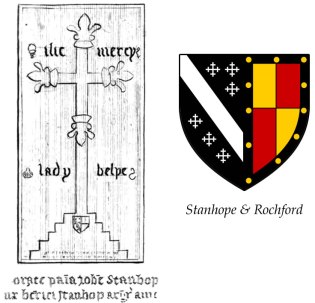
“Jesu mercy. Lady Helpe.”
“Orate pro aia Johanne Stanhope uxor Henrici Stanhope Arm.”
In English, the second line is:
“Pray for the soul of Joan Stanhope, wife of Henry Stanhope, esquire.”
The Visitations of the 1500s and 1600s report that Joan was the heiress of her insane, younger half-brother Ralph Rochford V, who had the family property at Stoke Rochford and Arley. But this is incorrect since Ralph was still alive in 1512, at least two years after Joan died.
Henry Stanhope married again to Elizabeth Bussy, a daughter of John Bussy of Hougham (he was a descendant of the Sir John Bussy who had been a close associate of the Rochfords in the later 1300s). Henry and Joan’s son Edmund, meanwhile, married a lady named Alice, who appears to have been a daughter of John Flygh, one of Henry VII’s yeomen of the wardrobe. This has the whiff of a dangerous liaison about it – Flygh’s social status was well below the Stanhopes’, but he had connections deep into the nerve centres of the royal Tudor household, where elevation or destruction could come fast to any man or woman prepared to play the game.
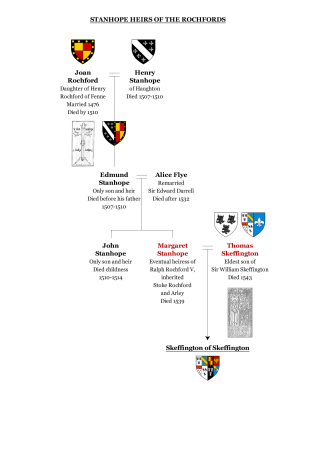
Edmund and Alice had two children, John and Margaret, but he would not live to see them grow up. He died before his father Henry, some time between March 1407 and July 1510, when he cannot have been more than 34 years old. Henry himself died soon after, before 14 July 1510, when his second wife Elizabeth was referred to as his widow in a royal pardon.
On 4 November that year Henry VIII granted Edmund’s widow, Alice, the wardship of their young son and heir, John, and his lands and marriage. But John soon died too, before he had come of age. The ongoing legal rows between members of the Stanhope family reveal that by 22 November 1514 John’s sister Margaret was now the sole surviving heiress of their late grandfather Henry Stanhope. She was therefore also the sole heiress of their late grandmother Joan Rochford, and – once there were no remaining male heirs – of their great-grandfather Henry Rochford too.
At this time young Margaret Stanhope was still in the care of her mother, Alice, who had remarried the Wiltshire knight Sir Edward Darrell. But by about 1518 Margaret was married to Thomas Skeffington, the eldest son of Sir William Skeffington of Leicestershire. Margaret died young, on 12 January 1539 (she cannot have been much older than 43) and Thomas on 29 July 1543. An inquisition carried out soon after confirmed that Margaret’s properties included “the manor of Stoke Rochford, Lincolnshire; with 2000 acres of arable, 100 of pasture, 300 of wood, 200 of meadow, and 200 of rushes and furze, in Stoke Rochford, South Stoke, Obthorpe, and Eston”. This seems to have included Arley too, since her descendants would have both.
These were the properties the Rochfords had inherited from the Huntingfields and the Limesys in the 1300s, and then added to through various acquisitions over the generations. They were the same properties mad Ralph Rochford V had held in 1512. After he died they ought to have passed to his nephew John Rochford V who chained up his wife at Rochford Tower in Fenne. But evidently John died childless too, and so it was that these remnants of the family property ended up with Margaret: she was the only surviving heir of the family through her grandmother Joan Rochford.
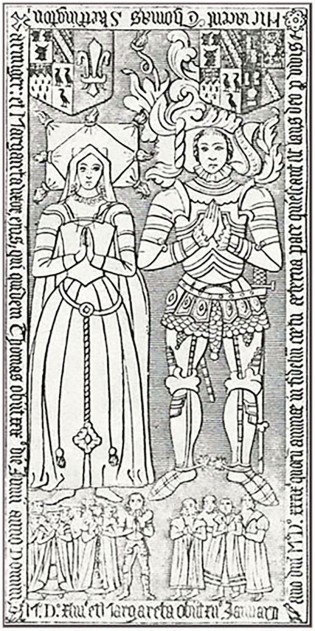
Thomas and Margaret were buried together in Skeffington church under a stone slab, which had their effigies, arms and an inscription incised into it. Only the bottom part of this is still visible today, but John Nichols was able to include a detailed drawing of it in his History and Antiquities of the County of Leicester published around 1800. The inscription read:
“Hic jacent Thomas Skeffington armiger, et Margaretta uxor ejus, qui quidem Thomas obiit xxix die Julii, anno domini MDXLIII, et Margareta obiit xii Januarii anno domini MDXXXIX, quorum animae in fidelium caetu aeterna pace quiescant. Sit laus Deo pro vivis et defunctis.”
“Here lie Thomas Skeffington esquire, and Margaret his wife, which Thomas died 29 day of July, in the year of our lord 1543, and Margaret died 12 January, in the year of our lord 1539, may their souls rest in eternal peace in the company of the faithful. Praise be to God for the living and the dead.”
The arms for Margaret’s side of the family were placed above Thomas’ effigy. They include many coats that could also be seen in the windows of Stoke Rochford church: for the Rochfords, the quarters of gold and red in a black border with gold coins on it, Quarterly or and gules, a border sable bezanty; for the Limesys, a gold eagle spread on a red field, Gules, an eagle displayed or; and for the Scropes, a blue field with a gold, diagonal stripe, Azure, a bend or. This last one was a mistake: Margaret’s great-grandmother was Joan Thurland, not Elizabeth Scrope, but perhaps her children did not know this.
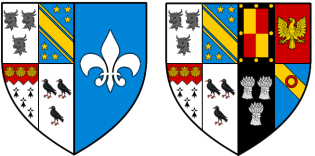
Whoever designed Thomas and Margaret’s tomb chose not to include any arms of the Stanhopes or their ancestral families. Perhaps the long and bitter argument over property at Haughton had left bad blood. If so, the matter would be forgotten within a generation: later members of the Skeffington family would include these too on their monuments, in some cases squeezing in as many coats they could think of.
There was one final coat on the tomb for Margaret’s side of the family: a black field with three silver sheaves of corn on it – Sable, three garbs ar. According to Gervase Holles’ notes and William Wyrley’s drawings, this coat also appeared in a window in the nave of Stoke Rochford church alongside the Rochfords’ arms, and on Henry Rochford’s tomb too, although it is not there today. This coat is best known in connection with the early Segrave family, but an entry for the Skeffingtons in the Leicestershire Visitation of 1619 claimed it was inherited from a family called Cambridge. Neither of these families is known to have had any connection with the Rochfords. But Bernard Burke, in his 1864 General Armoury, reported that this coat had also been used by a family named Fenne. It is not known whether the Rochfords’ 1100s ancestors Alan and Ralph of Fenne had a coat of arms of their own – it was only in the 1200s that it became the norm for knights to do so. Perhaps later family members devised the coat to represent their ancestors and origins at Fenne four centuries earlier.
Next: Unfinished business →
